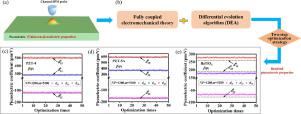当前位置:
X-MOL 学术
›
Int. J. Mech. Sci.
›
论文详情
Our official English website, www.x-mol.net, welcomes your
feedback! (Note: you will need to create a separate account there.)
Resolving the piezoelectric properties through differential evolution algorithm via piezoresponse force microscopy
International Journal of Mechanical Sciences ( IF 7.1 ) Pub Date : 2021-01-01 , DOI: 10.1016/j.ijmecsci.2020.106034 C.S. Feng , R.K. Zhu , W.J. Ming , K. Pan , J.L. Peng , Y.Y. Liu , C.H. Lei
International Journal of Mechanical Sciences ( IF 7.1 ) Pub Date : 2021-01-01 , DOI: 10.1016/j.ijmecsci.2020.106034 C.S. Feng , R.K. Zhu , W.J. Ming , K. Pan , J.L. Peng , Y.Y. Liu , C.H. Lei

|
Abstract Piezoresponse force microscopy (PFM) has rapidly become an important tool for characterizing electromechanical properties in piezoelectric materials at the nanoscale. However, there remains a challenge on the accurate quantitative determination of the piezoelectric coefficients through the electromechanical responses in PFM experiments, due to the long-range electroelastic interactions between the charged scanning probe of the microscopy and piezoelectric mediums. In this paper, differential evolution algorithm (DEA) has been utilized to quantitatively analyze the piezoelectric properties of transversely isotropic piezoelectric mediums via PFM experiment. Considering the coupling between piezoelectric mediums and air, we first extend the fully coupled theory to calculate the electromechanical responses including surface displacements and potentials underneath the probe. We further observe the relations among electromechanical responses, intrinsic piezoelectric properties and measurement conditions, which point us to choose the proper measurement conditions and optimization strategy during the resolving process through DEA. Finally, all the components of the transversely isotropic piezoelectric coefficients are successfully resolved after two-step optimization through the DEA combined with the fully coupled theory. This study provides an important guidance for quantitative and high-throughput determination of the electromechanical properties via PFM experiments.
中文翻译:

通过压电响应力显微镜通过差分进化算法解析压电特性
摘要 压电响应力显微镜 (PFM) 已迅速成为表征纳米级压电材料机电性能的重要工具。然而,由于显微带电扫描探针和压电介质之间的长程电弹性相互作用,在 PFM 实验中通过机电响应准确定量确定压电系数仍然存在挑战。本文采用微分演化算法(DEA)通过PFM实验定量分析横向各向同性压电介质的压电特性。考虑压电介质与空气的耦合,我们首先扩展全耦合理论来计算机电响应,包括探头下方的表面位移和电位。我们进一步观察了机电响应、固有压电特性和测量条件之间的关系,这为我们在通过 DEA 解析过程中选择合适的测量条件和优化策略提供了指导。最后,通过DEA结合全耦合理论两步优化后,横向各向同性压电系数的所有分量都得到了成功解析。该研究为通过 PFM 实验定量和高通量测定机电性能提供了重要指导。固有压电特性和测量条件,这表明我们在通过 DEA 解析过程中选择合适的测量条件和优化策略。最后,通过DEA结合全耦合理论两步优化后,横向各向同性压电系数的所有分量都得到了成功解析。该研究为通过 PFM 实验定量和高通量测定机电性能提供了重要指导。固有压电特性和测量条件,这表明我们在通过 DEA 解析过程中选择合适的测量条件和优化策略。最后,通过DEA结合全耦合理论两步优化后,横向各向同性压电系数的所有分量都得到了成功解析。该研究为通过 PFM 实验定量和高通量测定机电性能提供了重要指导。通过DEA结合全耦合理论两步优化后,横向各向同性压电系数的所有分量都得到了成功解析。该研究为通过 PFM 实验定量和高通量测定机电性能提供了重要指导。通过DEA结合全耦合理论两步优化后,横向各向同性压电系数的所有分量都得到了成功解析。该研究为通过 PFM 实验定量和高通量测定机电性能提供了重要指导。
更新日期:2021-01-01
中文翻译:

通过压电响应力显微镜通过差分进化算法解析压电特性
摘要 压电响应力显微镜 (PFM) 已迅速成为表征纳米级压电材料机电性能的重要工具。然而,由于显微带电扫描探针和压电介质之间的长程电弹性相互作用,在 PFM 实验中通过机电响应准确定量确定压电系数仍然存在挑战。本文采用微分演化算法(DEA)通过PFM实验定量分析横向各向同性压电介质的压电特性。考虑压电介质与空气的耦合,我们首先扩展全耦合理论来计算机电响应,包括探头下方的表面位移和电位。我们进一步观察了机电响应、固有压电特性和测量条件之间的关系,这为我们在通过 DEA 解析过程中选择合适的测量条件和优化策略提供了指导。最后,通过DEA结合全耦合理论两步优化后,横向各向同性压电系数的所有分量都得到了成功解析。该研究为通过 PFM 实验定量和高通量测定机电性能提供了重要指导。固有压电特性和测量条件,这表明我们在通过 DEA 解析过程中选择合适的测量条件和优化策略。最后,通过DEA结合全耦合理论两步优化后,横向各向同性压电系数的所有分量都得到了成功解析。该研究为通过 PFM 实验定量和高通量测定机电性能提供了重要指导。固有压电特性和测量条件,这表明我们在通过 DEA 解析过程中选择合适的测量条件和优化策略。最后,通过DEA结合全耦合理论两步优化后,横向各向同性压电系数的所有分量都得到了成功解析。该研究为通过 PFM 实验定量和高通量测定机电性能提供了重要指导。通过DEA结合全耦合理论两步优化后,横向各向同性压电系数的所有分量都得到了成功解析。该研究为通过 PFM 实验定量和高通量测定机电性能提供了重要指导。通过DEA结合全耦合理论两步优化后,横向各向同性压电系数的所有分量都得到了成功解析。该研究为通过 PFM 实验定量和高通量测定机电性能提供了重要指导。











































 京公网安备 11010802027423号
京公网安备 11010802027423号